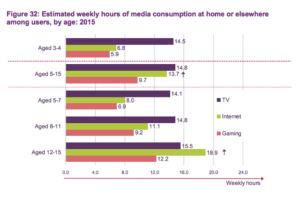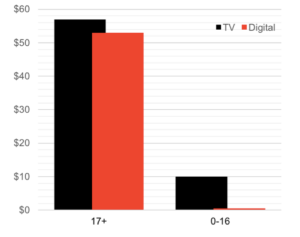How Kids' Digital Media is Turning into a Multi-Billion-Dollar Opportunity
by Lindsay Rowntree on 20th Apr 2016 in News

Advertising to children is a huge and controversial business. Turn on the TV at a certain time of day and you will be met with a barrage of adverts showcasing the latest, 'must-have' toy. Known as 'Centennials", kids today are the most digitally savvy generation of our time; so, is TV the best way to reach them? ExchangeWire speaks with Dylan Collins (pictured below), CEO, SuperAwesome, who gives a fascinating overview of the kids' digital market and explains why the industry needs to embrace it, despite the significant challenges that exist.
ExchangeWire: Many wouldn’t be aware of the existence of a kids’ digital media market. How has this market developed?
Dylan Collins: For years, the kids’ media market was dominated by TV. The underlying wisdom was that TV simply wasn’t going away. The powerhouses of Disney, Cartoon Network, and Nickelodeon reigned supreme.
Yet, all of that has changed completely over the last two years. TV viewing has nose-dived and digital budgets are now growing at 50% per annum. What just happened?
Firstly, viewing started to change. This was being driven by the insatiable appetite for content by the Centennial generation. Today, almost 90% of kids have access to a tablet with direct ownership growing by 20-30% annually. This isn’t news; and for a long time brands were able to ignore it. But then the TV decline started. Nickelodeon are down 30% in eighteen months. Disney have been public about their subscriber growth.

To understand the kind of seismic effect this is starting to have on the market, look at the graph below. In most audience markets, the split between TV and digital advertising investment is approximately 60/40. In the kids space, it’s 95/5. The mathematical inevitability is now happening; and the digital ad market for kids is turning into a multi-billion-dollar opportunity.

2015 Advertising Spend, USD$ millions
Secondly, the world stopped ignoring kids. For years, the standard approach by Silicon Valley was to assume that nobody under the age of 13 actually used the internet. Instead, the politicians took the lead and started passing specific data privacy laws around kids and the internet. What has become standard in the US (COPPA), and in the process of rollout across Europe (GPRD), is a complete ban on any data-gathering (including cookies or similar unique identifiers) for an under-13 audience. In effect, this makes the kids/family market a completely separate platform, requiring new technology to handle all these compliance requirements for digital media. So, the industry is not just faced with a rapid migration to an entirely new platform (digital), they also have to invest in new infrastructure to operate there without breaking the law.
With the legal implications surrounding kids’ advertising, and the lack of infrastructure, how did SuperAwesome address this seemingly insurmountable challenge?
Three years ago, we predicted this perfect storm of trends, and specifically that the kids’ digital media industry was going to need new infrastructure to function both safely and sustainably for everyone. Today, our technology is used by hundreds of brands and content owners in the kids space to enable kid-safe advertising, monetisation, content creation, and safe-social conversations. Our KidAware certification program has been rolled out to most major media agencies around the world. We have a pretty good perspective on where exactly this market is going.
Why should marketers and publishers care about this young digital audience? What’s at stake for them?
 What’s at stake? Take your pick: the early adopters of your product, the migration of billions of TV dollars, the creation of new generation-lasting content franchises. It’s why we’re seeing the growing interest across non-traditional kids brands into sectors like electronics and cars: how many pre-orders for the latest Tesla were given the once-over by a child before the parent tapped the purchase button?
What’s at stake? Take your pick: the early adopters of your product, the migration of billions of TV dollars, the creation of new generation-lasting content franchises. It’s why we’re seeing the growing interest across non-traditional kids brands into sectors like electronics and cars: how many pre-orders for the latest Tesla were given the once-over by a child before the parent tapped the purchase button?
This new generation of kids are more disruptive than anyone imagines. Silicon Valley have finally realised this; and we’re now seeing the powerhouses like Google, Amazon, and Twitter publicly thinking about under-13 strategies. As challenging as it may be, it’s clear that ignoring kids is not a viable option if your business is predicated on services which they don’t care about (e.g. email, social networks, etc). Google announced their Google for Kids strategy (YouTube launched YouTube Kids). Amazon has aggressively entered the space with content. Twitter and Snapchat have both attempted kids’ versions of their apps. Facebook have been so noticeable by their absence at the table that it’s an equally obvious signal.
Toy companies, faced with the need to build digital ecosystems as extensions for their physical product, are rapidly building digital DNA through acquisitions, partnerships, and experimentation.
As typical rules don’t apply here, how can the industry even start to conceive, let alone execute, a strategy targeting the powerful and influential kids audience through digital media?
Probably the greatest challenge for the media incumbents is the need for technology investment. The kids market is best understood as a separate platform. Different behaviour, different requirements, different standards, different technology. Our entire platform is essentially built on a zero-data architecture. All advertising is served entirely based on the content of the app/site, and never on the profile of the viewer.
From a brand’s perspective, we make all this seamless. But behind the scenes there has been huge investment. Much of our development has been around recreating many of the online ad paradigms for the under-13 space. When you consider tracking concepts, like attribution, without unique identifiers you begin to get the scale of the challenge.
By the way, this is not heralding the death of TV (check my resume). Kids TV will continue to be an incredibly powerful medium; but certainly there is a clear underweighting towards digital which is happening rapidly.
Our mission has been to build the infrastructure that allows this market to function safely and effectively. Safe for kids, effective for brands, sustainable for content owners. Bear in mind the creator of the next Thomas the Tank Engine or Peppa Pig will come from a digital channel.
Digital MarketingDisplayTargeting








Follow ExchangeWire